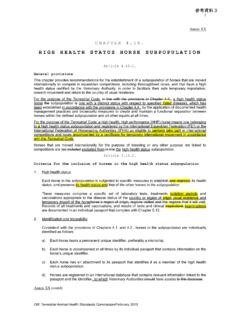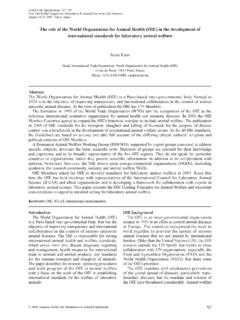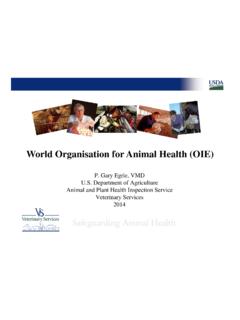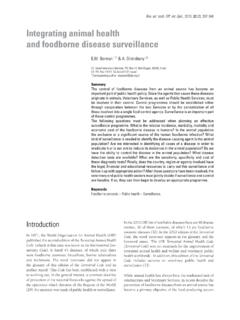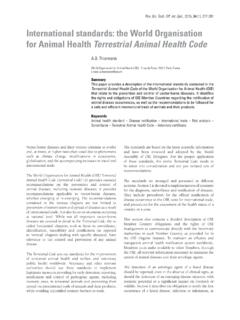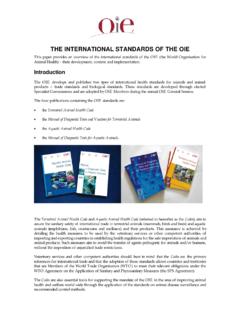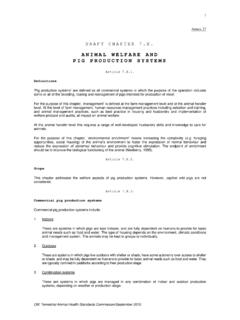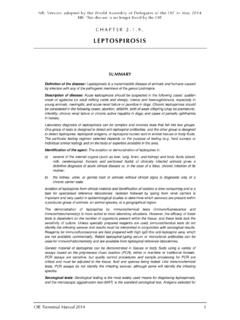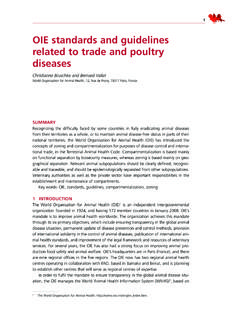Transcription of Stray Dog Population Control - oldrpawe.oie.int
1 1 Stray Dog Population Control terrestrial animal health Code Chapter Dr Tomasz Grudnik OIE International Trade Department First OIE regional workshop on (national strategy) Stray dog Population management for Balkan countries Bucure ti / Rom nia, 17-19 June 2014 2 2 Background In May 2006, the OIE recognised the importance of providing guidance to members on humane methods of Stray dog Population Control and decided develop specific animal welfare standard for this important topic. In 2009 at the OIE 77th General Session, the Chapter on Stray Dog Population Control was unanimously adopted and included in the TAHC 3 3 Why did the OIE develop this chapter?
2 More than 55 000 people die each year from rabies. A majority are children and in many cases the source of infection is a Stray dog. 99% human rabies deaths due to dog bites Many millions of animals contract and die of rabies each year. Stray dogs pose serious human health , socio-economic, political and animal welfare problems in many countries of the world, and especially in developing countries and in least developed countries. 4 4 - RESOLUTION No. 30 - 77 GS/FR PARIS, May 2009 - Annex XV - OIE terrestrial animal health Standards Commission / March 2009 - Appendix VII - DRAFT GUIDELINES DOG Population Control - OIE terrestrial animal health Standards commission/March 2007 - REPORT OF THE FIFTH MEETING OF THE OIE WORKING GROUP ON animal WELFARE Paris.
3 4 - 6 July 2006 Item No 12 - Stray animal Control TOR modified to concentrate on dog Population Control programs Links to capture the 5 5 Preamble Stray and feral dogs pose serious human health , animal health and welfare problems and have a socio-economic, environmental, political and religious impact in many countries Human health , including the prevention of zoonotic diseases, notably rabies, is a priority Dog Population management is an integral part of rabies Control programs 6 6 Preamble OIE recognizes the importance of controlling dog populations without causing unnecessary animal suffering Veterinary Services should play a lead role in preventing zoonotic diseases and ensuring animal welfare and should be involved in dog Population Control .
4 Coordinating their activities with other competent public institutions and/or agencies 7 7 Guiding principle Promotion of responsible dog ownership. Dog ecology is linked with human activities. Control of dog populations has to be accompanied by changes in human behaviour to be effective 8 8 Dog Population Control program objectives Improve health and welfare Reduce numbers of Stray dogs to acceptable level Promote responsible ownership Creation and maintenance of a rabies free dog Population Reduce the risk of other zoonotic diseases Manage other human health risks Prevent harm to the environment and biodiversity (pack of dogs hunting wildlife in peri-urban areas)
5 Prevent illegal trade 9 9 Responsibilities and competencies Dog Population Control Program Veterinary Authority Other government agencies Private sector veterinarians NGOs Local government authorities Dog owners 10 10 Development of a dog Population Control program ADVISORY GROUP (veterinarians, experts in dog ecology, dog behavior and zoonotic diseases, and representatives of relevant stakeholders (local authorities, human health services/authorities, environmental Control services/authorities, NGOs and the public) Analyze and quantify the problem Identify the causes Obtain public opinion on dogs Propose the most effective approaches to use in the short and long term 11 11 Important considerations Identifying the sources of Stray dogs Estimating the existing number, distribution and ecology Regulatory framework Resources available to authorities 12 12 Important considerations Identifying the sources of Stray dogs Owned dogs that roam freely.)
6 Dogs that have been abandoned by their owner, including puppies resulting from uncontrolled breeding of owned dogs; Unowned dogs that reproduce successfully 13 13 Important considerations Estimating the existing number, distribution and ecology Practical tools that are available include registers of dogs, Population estimates, and surveys of dogs owners, dog shelters and veterinarians. The important factors relevant to the dog carrying capacity of the environment include food, shelter, water and human attitudes and behaviour.
7 14 14 Important considerations Regulatory framework registration and identification dogs, vaccination against rabies, veterinary procedures, Control of dog movement environmental Control , regulation of dog shelters, animal welfare obligations of owners and authorities 15 15 Important considerations Resources available to authorities human resources, financial, technical tools, infrastructure, cooperative activities, public-private-NGO partnerships, central state or province local 16 16 Control measures Education and legislation for responsible ownership (collaboration with local governmental authorities, NGOs, kennel clubs, private vets, and vet organisations assist Veterinary Authorities in establishing and maintaining programs) Registration and identification of dogs (core component for the Control of the dog Population ) Reproductive Control (surgical and chemical sterilisation, chemical contraception and separation during oestrus)
8 Removal and handling (CA should capture, collect and transport humanely dogs following the relevant legislation procedures) 17 17 Control measures Capture and return, rehoming or release (clear procedure and standards developed by the CA) Environmental controls Control of dog movement international (export/import) Control of dog movement within the country ( leash law, roaming instructions) Regulation of dog dealers (encourage dealers to form or join association respecting the rules and legislation) Reduction in dog bite incidence (the most effective means are education and placing responsibilities on the owner) Euthanasia 18 18 Euthanasia Euthanasia of dogs, used alone, is not an effective Control measure.
9 If used, it should be done : -following general principles of terrestrial Code -with emphasis on using the most practical, rapid and humane methods -minimizing distress, anxiety and pain by ensuring that operators are appropriately trained -in combination with other measures to achieve effective long term Control 19 19 Monitoring and evaluation of dog Population Control programs To improve performance To demonstrate that the programme is achieving its aims To compare different strategies Indicators (dog Population size and related subpopulations, dog welfare, prevalence of zoonotic diseases, people attitudes and behaviour)
10 Sources of information (surveys, questionnaires, focus groups, expert opinions, direct observation, data records) 20 Thank you for your attention!
